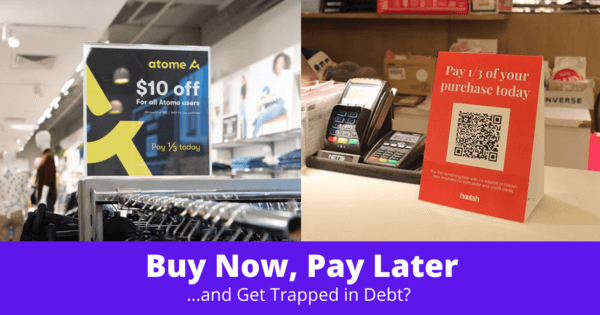Advertisement
OPINIONS
Buy Now, Pay Later... and Get Trapped in Debt?
The dangers of BNPL services and what you can do to make the most out of them
Nicholas Beh
28 Dec 2020
Student Ambassador 2020/21 at Seedly
If you have been shopping recently – online or offline – you may have seen a new form of payment offering you interest-free instalments, with no strings attached! Companies such as Atome, Hoolah, OctiFi and Rely have partnered with major retailers such as Sephora, Qoo10 and Nike to offer such services to consumers.
Buy Now Pay Later (BNPL) services may be new here but have been wildly popular and successful in many other countries including Australia and the US. Afterpay is one notable example, achieving a massive A$32 billion market capitalization in merely 5 years. But apart from being a commercial success, are BNPL services truly beneficial to us consumers? Here are some of their pitfalls and what you can do to make the most out of these services!
Designed to get you to spend more
It is no surprise as to why retailers love BNPL services – by breaking down a large payment into multiple instalments, customers perceive themselves to have more spending power than they actually have, and items to be cheaper than they are. Local BNPL providers Atome and Hoolah boast incredible stats, such as a 3x growth in transaction value (Hoolah & BHG), or a 15x increase in daily transactions (Atome & IUIGA).

Picture source: Hoolah
In fact, Hoolah openly advertises the fact that they can increase customers’ basket size and drive upsell. Which really makes you think – are these providers acting in your best interest?
A debt trap for the financially stretched
With most of these services having an age requirement of just 18 years old, and near-instant approvals with "AI-powered" creditworthiness checks, it is clear that BNPL services mainly target a younger demographic with lower incomes. Banks on the other hand, have a shared credit scoring system, strict income requirements and credit limits proportionate to income.
Since most BNPL services allow you to charge to a credit card, there is a significant risk where customers may overleverage themselves by charging these BNPL instalments to their credit card, extending their debt and essentially circumventing the credit limits set by their banks. Coupled with the high interest rates of credit cards and the additional debt from BNPL services, this could potentially result in debt snowballing very well beyond the paying ability of customers.
In November 2020, the Australian Securities and Investments Commission (ASIC) released an update on Australia’s BNPL industry. The numbers speak for themselves, and they show that:
21% of BNPL users missed a payment in the last 12 months
45% of transactions that missed payments had incurred multiple missed payment fees
20% of BNPL users missed paying other bills in order to pay their BNPL payments on time
BNPL users are more likely to incur interest charges on credit cards
BNPL users are more likely to have higher credit limit use

Even more stark are the outcomes of some BNPL users, where they even have to cut back on essentials, or take out an additional loan in order to make payments:

It is also unclear what BNPL services will do should customers run into financial difficulty and find themselves unable to pay the balance off. Unlike their more established overseas counterpart Afterpay, local BNPL services do not offer any “hardship” policy and instructs users to email support instead.
A useful tool for earning card rewards
A potentially useful purpose of BNPL services, apart from budgeting, is to maximize credit card rewards. Unlike regular bank instalment payment plans, BNPL services are eligible to earn rewards on most cards (for now!). Many cards that offer high cashback or miles earn rates often have monthly minimums or caps, making it tricky to optimize your expenditure.
If you were to use the Citi Rewards card (which earns 4 miles per dollar up to $1,000 per month), a purchase of $2,000 will blow through the monthly cap and you would waste a potential 4,000 miles! By splitting your payments, you will be able to maximize your rewards and earn the full 4 miles per dollar. Similarly, this can work with cards that require a minimum monthly spend to earn rewards/interest, such as UOB One.
Additionally, because most BNPL services require you to register on an app and pay online, you can convert offline in-person spending to online spending, which is a category that many cards give higher rewards for. You can even pay off the remaining amount early with no penalty if you want to!
What lies ahead?
As the traditional players in payments start to catch on, expect more competition and a variety of options for BNPL in the future. Mastercard is already starting to roll out their solution in Singapore and Razer Fintech has partnered with Rely to bring BNPL to their merchants.
We can also expect regulators to start clamping down on BNPL, since most regulations regarding banking and credit are currently not applicable to BNPL. In Australia, regulators are already beginning to draft and enact regulations to protect consumers. Banks, whose lines of business are impacted by BNPL, may also restrict BNPL transactions on their own cards or exclude them from earning rewards – Capital One (in the US) has banned BNPL transactions from their credit cards just a few weeks ago and others may follow suit soon.
Like with all good credit card “hacks”, enjoy it while it lasts! Make sure you spend only what you have, and within your means. Use BNPL services as tools and not as alternative sources of credit.
Cover image source: Atome, Hoolah
Comments
1405
7
ABOUT ME
Nicholas Beh
28 Dec 2020
Student Ambassador 2020/21 at Seedly
I like money
1405
7
Advertisement
No comments yet.
Be the first to share your thoughts!
